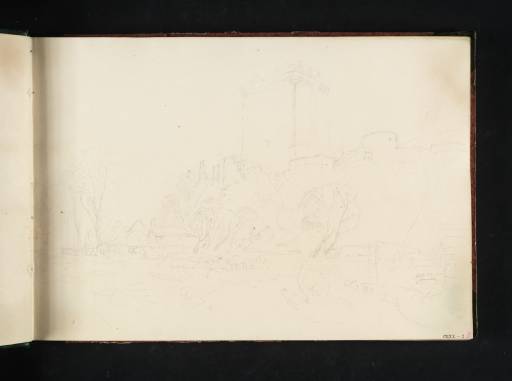Joseph Mallord William Turner Design for 'Borthwick Castle' 1818-19
Image 1 of 2
Joseph Mallord William Turner,
Design for 'Borthwick Castle'
1818-19
Joseph Mallord William Turner 1775–1851
Folio 2 Recto:
Design for ‘Borthwick Castle’ 1818–19
D13815
Turner Bequest CLXX 2
Turner Bequest CLXX 2
Pencil on off-white wove paper, 177 x 256 mm
Faint pink remains of John Ruskin’s red ink inscription bottom right
Stamped in black ‘CLXX – 2’ bottom right
Faint pink remains of John Ruskin’s red ink inscription bottom right
Stamped in black ‘CLXX – 2’ bottom right
Accepted by the nation as part of the Turner Bequest 1856
References
1909
A.J. Finberg, A Complete Inventory of the Drawings of the Turner Bequest, London 1909, vol.I, p.493, CLXX 2, as ‘Design for “Borthwick Castle”.’.
1974
Martin Butlin, Andrew Wilton and John Gage, Turner 1775–1851, exhibition catalogue, Royal Academy, London 1974, p.85 under cat.203.
1982
Francesca Irwin, Andrew Wilton, Gerald Finley and others, Turner in Scotland, exhibition catalogue, Aberdeen Art Gallery and Museum 1982, p.45 under cat.45.
2000
Eric Shanes, Evelyn Joll, Ian Warrell et al., Turner: The Great Watercolours, exhibition catalogue, Royal Academy of Arts, London 2000, p.112 under cat.36.
1979
Andrew Wilton, J.M.W. Turner: His Life and Work, Fribourg 1979, p.426 under cat.1060.
As Finberg noted,1 this sketch was the compositional design for Turner’s Borthwick Castle, 1818 (Indianapolis Museum of Art).2 The drawing was probably made in Turner’s studio, based on an on-the-spot sketch in the Scotch Antiquities sketchbook (Tate D13724; Turner Bequest CLXVII 76), made on a visit to Scotland in October–November 1818. Turner also made another sketch from a slightly different angle which contributed to the final design (Tate D13723; Turner Bequest CLXVII 75a).
The view of both studies is from the north-west and shows the castle on a hill with the River Gore in front and two small cottages below it to the left. Trees are dotted around the landscape and the Lammermuir Hills are seen in the distance. The present study is drawn in less detail than either of these, with the castle drawn mainly in outline apart from details of the corbels and remains of the roof, and the rest of the landscape drawn carefully but rather faintly. Turner’s intension was to map out the composition of his final design as clearly as possible, leaving out details for which he could refer to the two Scotch Antiquities sketches.
By paying particular attention to D13724, Finberg, and hence subsequent writers, have neglected the significance of D13723, which perhaps played an equally important role in the compositional study. Indeed the overall layout, with the castle placed at the upper centre of the composition is closer to this latter sketch than the former which placed the castle slightly left of centre. The viewpoint of D13723 is also more similar to the present design, where we look directly towards the north-east corner, rather than coming round to the north as in D13724. The present design, however, finds a midpoint between the two views. Turner also took the liberty to pick and choose from each sketch, using the trees from D13724, but taking the cottages from D13723. One feature in the design, however, came from neither sketch – the small arched bridge at the bottom right. For this Turner may have referred to another sketch (D13725; Turner Bequest CLXVII 76a top sketch; and also D13727; CLXVII 77a). The bridge is not included in the Borthwick watercolour, which is otherwise very close to the composition of this design, though, as noted, must have drawn upon other sketches for architecture and other details. See also a similar view in the Edinburgh sketchbook (1818) (Tate D13503; Turner Bequest CLXVI 28).
Turner made another sketch of Borthwick Castle in the Scotland and London sketchbook (folio 1; D13814; CLXX 1), which seems to be an alternative design. It is also worth mentioning a sketch by Edward Blore made after Turner’s watercolour of Borthwick which he appended to a letter to Walter Scott in January 1819.3 It was this sketch that Scott based his description of the castle for Provincial Antiquities upon, as he had not yet seen the watercolour or engraving.4
This sketch by Blore also provides a narrow period within which Turner must have made these studies. Having returned from Scotland by 1 December 1818,5 Turner completed these studies prior to painting his finished watercolour which Blore had seen and copied before 25 January 1819.
Edward Blore to Walter Scott, 25 January 1819, National Library of Scotland, MS 3890, folios 25–6 verso.
Katrina Thomson, Turner and Sir Walter Scott: The Provincial Antiquities and Picturesque Scenery of Scotland, exhibition catalogue, National Gallery of Scotland, Edinburgh 1999, p.100 cat.50.
Verso:
Blank
Thomas Ardill
August 2009
How to cite
Thomas Ardill, ‘Design for ‘Borthwick Castle’ 1818–19 by Joseph Mallord William Turner’, catalogue entry, August 2009, in David Blayney Brown (ed.), J.M.W. Turner: Sketchbooks, Drawings and Watercolours, Tate Research Publication, December 2012, https://www


